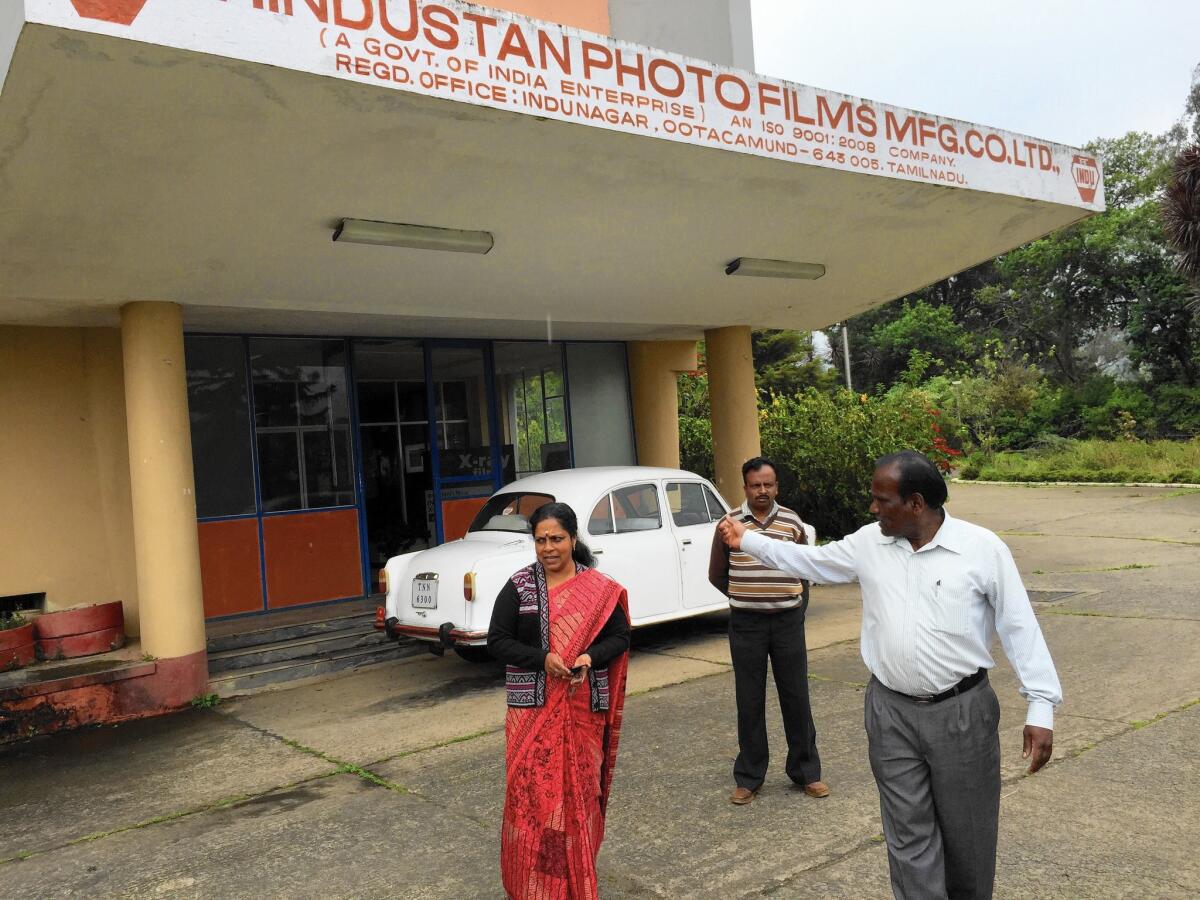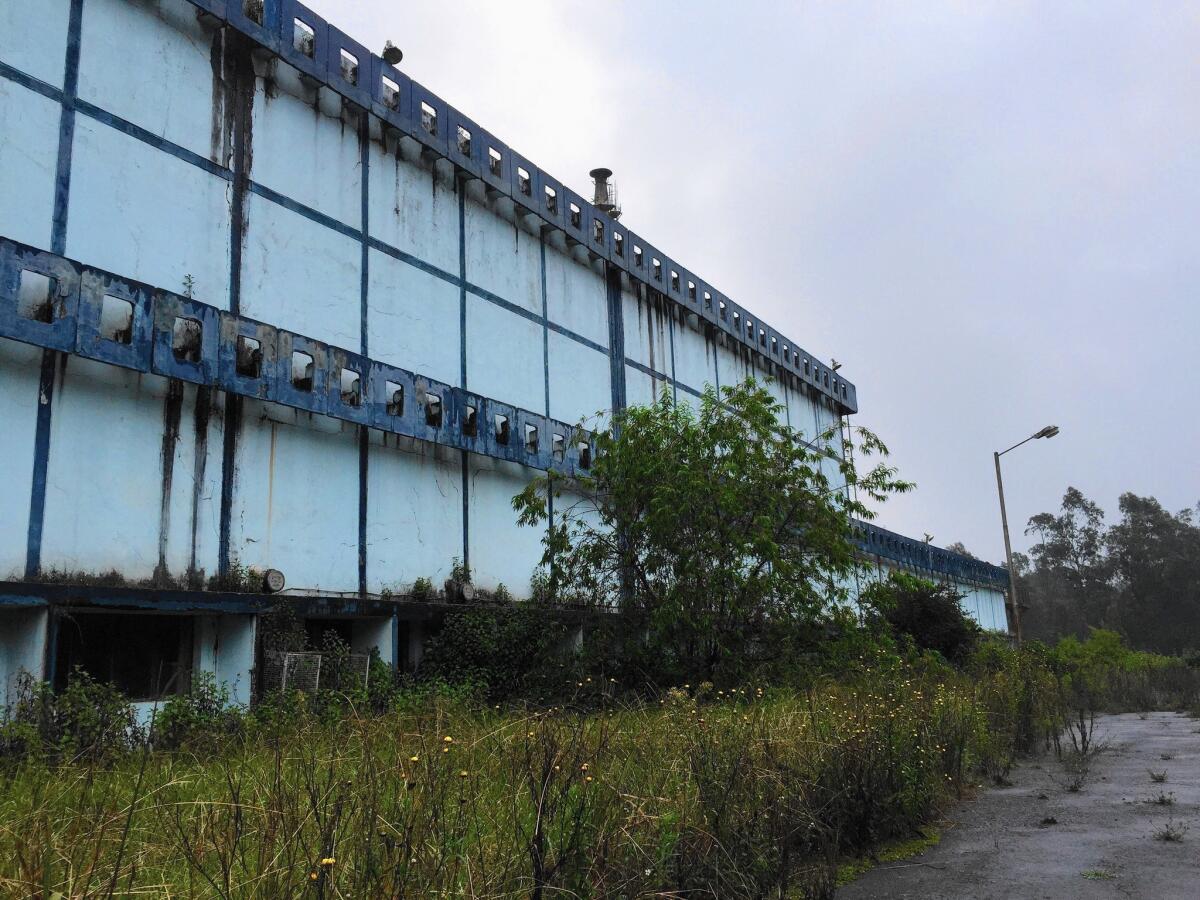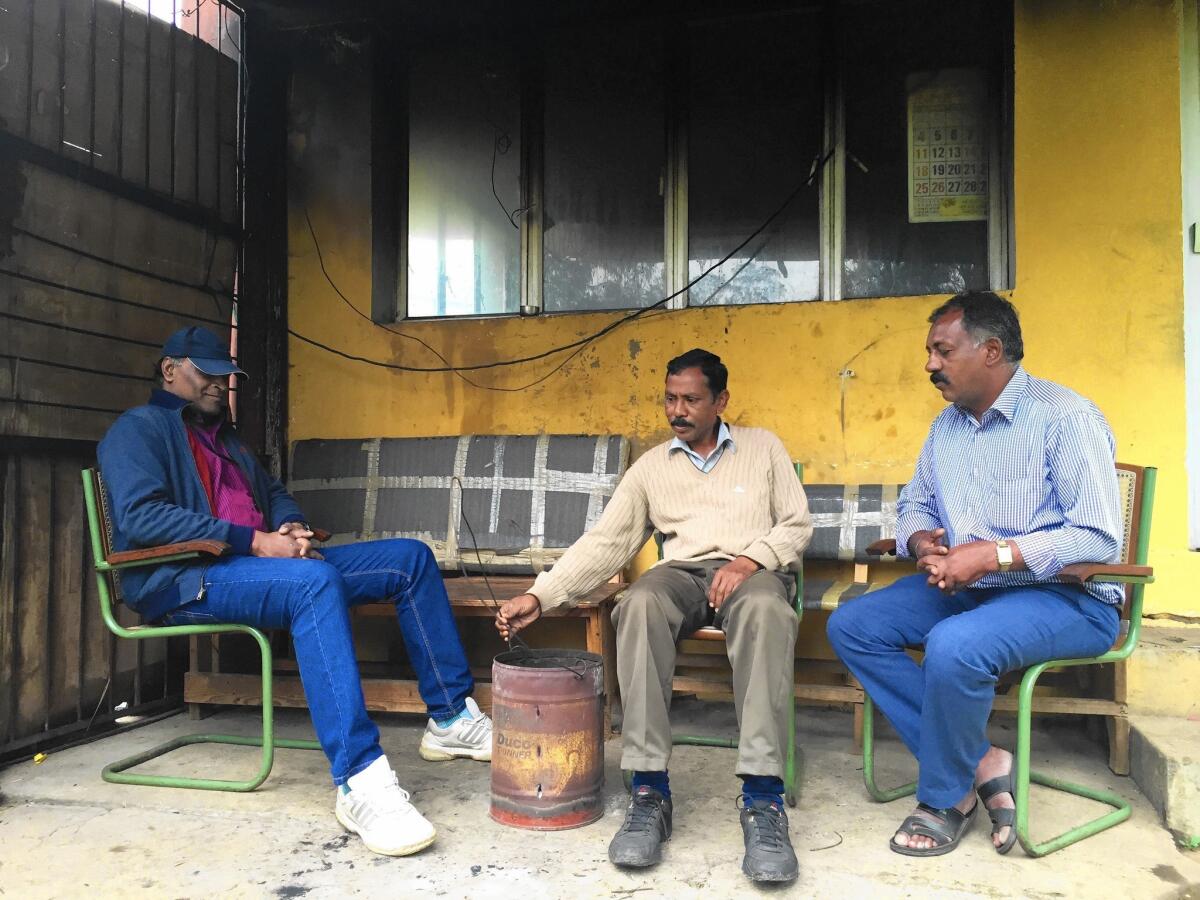Great Read: In India, the slow (slow) death of a black-and-white film maker

At India’s state-owned Hindustan Photo Films company, no work orders have arrived in more than a year. But about 300 employees still show up each morning.
Reporting from Udhagamandalam, India — In a musty reception room high in the southern Indian hills, a photo booth the size of a walk-in closet promises black-and-white pictures in four minutes. Groovy track lights illuminate a display table piled with X-ray film and movie-reel canisters.
They were among the flagship products of Hindustan Photo Films, but the state-owned film factory no longer makes them, or anything else. Production facilities were unplugged in 2012 because the government stopped sending money for the electric bill. No work orders have arrived in more than a year. About 300 employees still show up each morning, but most just punch their time cards and go home.
“It’s a very pathetic situation,” said M. Ramesh, the somber deputy finance manager, whose job is now limited to handing out paychecks and replying to the occasional email from the central government.
Ramesh was dressed all in black, as if for a funeral. “We are all just waiting to walk out the door,” he said.
More than a decade ago, Indian officials decided that Hindustan Photo Films should be shuttered, that the producer of paper for black-and-white photos and X-ray film was no longer viable in a full-color increasingly digital world.
“The products are outdated,” said Sadasivan Girishkumar, the government-appointed company chairman. “The requirement for photographic film is very low.”
Yet political patronage and the sluggish pace of India’s bureaucracy have kept HPF alive, barely, even as its losses creep steadily higher like the weeds and brush encircling its factories.
Over the last three fiscal years, the company has lost about $700 million, mostly interest on loans it was forced to take when government funds didn’t arrive, which was often. It is among the worst performers of the 290 government-owned enterprises, a motley roster that includes makers of watches, drugs, clothing, fertilizer, cooking oil, even condoms.

Political patronage and India’s bureaucracy have kept Hindustan Photo Films alive, barely, even as its losses creep steadily higher like the weeds and brush encircling its factories.
SIGN UP for the free Great Reads newsletter >>
The companies are a vestige of the nation’s early years, after independence from Britain in 1947, when India’s Soviet-inspired leaders tried to build an industrial base with heavily subsidized state-run manufacturing. Even today, as India becomes the fastest-growing major economy, the public sector still dominates major industries such as oil and mining, and the number of state-owned enterprises has risen by 70% since 1990.
Elected officials are loath to close down state companies, which usually guarantee steady employment, decent wages and a reliable vote bank. In 2011, a parliamentary committee recommended that HPF be revamped. That recommendation, along with a series of enthusiastic turnaround plans by company staff members and outside consultants, died on the desks of senior bureaucrats in New Delhi.
After half of the remaining 600 employees were let go this year, the unions went to court, contending that the government’s retirement package was inadequate. The employees are familiar with the term. They haven’t received a raise since 1987.
Yet even after persuading a judge to temporarily halt the closure process, workers know that time is running out.
“We fought all these years to save the company, but we lost the battle,” said A. Radhakrishnan, a union leader who has spent 28 years as a technician at HPF. “Now we are just fighting for our benefits.”
::
Like the black-and-white photos printed on its signature glossy paper, HPF invokes nostalgia for a simpler, sheltered time, before India began opening its economy to the world in the early 1990s.
The scenic but economically depressed Nilgiri Hills, home to long-marginalized forest tribes, had never had an industry of its size when the factory began production in 1960. At its height, nearly 5,000 employees, including dozens with PhDs and researchers from elite science colleges, filled a 350-acre campus carved into a pine and eucalyptus forest.
Employees raised their children in a tidy colony at the edge of an emerald-green lake. Management played badminton on the lawns of the prim Officers Club, built in the style of a small English manor.
The problem is the bureaucrats didn’t know how to run the business. They never gave us a chance to succeed.
— S.B. Ravindra, Hindustan Photo Films’ former senior finance manager
The wood-paneled conference room in the main building is still lined with trophies and commemorations of an era of clannish central planning: state-sponsored volleyball tournaments, visits by top politicians from New Delhi and even a plaque for “outstanding achievement in family planning.”
“Every day was like a festival,” said R. Ushakumari, whose father was one of the initial hires at the company. He retired as a foreman, and she signed on in 1989 as a secretary, a job she still holds.
“Even though it was thousands of people,” she said, “we were like a family.”
Yet from the outset, HPF operated like a test case for pitfalls of centrally planned manufacturing.
Beset by construction delays and cost overruns, it soon faced a bigger obstacle to success: A decade after the main factory opened, visiting U.S. and Japanese teams pronounced its technology nearly obsolete.
Color was quickly replacing HPF’s black-and-white reels and photo paper. For a few years the company made money by importing color film and selling it to the Indian film industry. But retail prices were set by the government, which was vulnerable to pressure from cost-conscious Bollywood producers, and soon the company began losing money on the color film too.
In the mid-1980s, even as the digital era loomed, the government invited the U.S. chemical company DuPont to design a new production facility for black-and-white analog film. Then, when the facility was nearly ready to open in 1991, India announced the first major reforms to liberalize its economy. The Indian rupee plummeted and the cost of HPF’s loans went through the roof, while foreign products began to flood the market.
“The government has cheated this company for the last 25 years,” said S.B. Ravindra, the company’s former senior finance manager, who was let go this year. He cited official statistics showing that India still spends $20 million a year to import medical and industrial X-ray film, which he said HPF could produce.
“The problem is the bureaucrats didn’t know how to run the business,” Ravindra said. “They never gave us a chance to succeed.”

Roy Rolen, left, with other security guards outside the Hindustan Photo Films factory in India. “We’re tired of sitting here all day and telling the same old stories about those golden years. That is over and it’s time to get out,” Rolen says.
Many employees tried to hang on, despite stagnant and often-delayed salaries, persuaded by politicians’ promises that the company would eventually be revived.
“Everyone once took pride in working for HPF, but that pride became such a bane,” Ravindra said. “It got so bad that if you worked for HPF, no one would marry you.”
Prime Minister Narendra Modi took office last year promising economic reforms that many hoped would include pulling the plug on dozens of ailing state companies. But none have been closed and some, including a scooter maker long ago given up for dead, have received handsome cash infusions.
“No one wants to take hard decisions because they’re worried about winning elections,” said Mohan Guruswamy, an economist and founder of the Center for Policy Alternatives, an independent think tank.
“The notion of liberal economics has never sunk in in India. There is still a distrust of private capital and foreign capital, and a consensus on state control of industries that cuts across parties. People still want a lifetime of employment, a lifetime of assured income.”
Outside the locked DuPont-designed factory, Roy Rolen was ready to give it up. After 20 years in the storage department, the towering 44-year-old was made a security guard when production ended. The electricity in the guard shack had been cut, so Rolen huddled with two other guards, both former technicians, around a small fire to stave off the autumn chill.
He has a few more working years left, he said, but after HPF closes he figures the only job he’ll get is as a security guard.
“That’s OK,” he said. “We’re tired of sitting here all day and telling the same old stories about those golden years. That is over and it’s time to get out.”
He motioned to the ashes of the dying fire. “Everything has been chewed up,” he said. “We’re just left with bits of dust.”
MORE GREAT READS
Survivors tell the camera the hidden tale of China’s Great Famine
Jesse is a typical boy in probation-run foster care: unwanted
A failed bronco gets a shot at rodeo redemption
More to Read
Sign up for Essential California
The most important California stories and recommendations in your inbox every morning.
You may occasionally receive promotional content from the Los Angeles Times.











